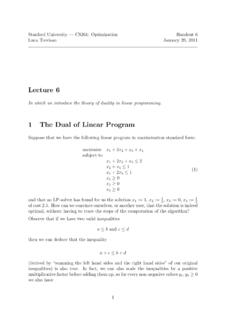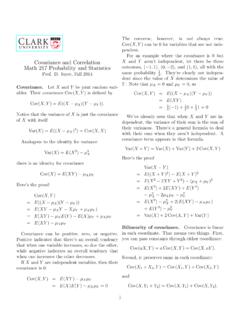Transcription of Linear Programming I: Maximization - Sam Baker
1 Linear Programming I 1 Linear Programming I: Maximization 2009 Samuel L. BakerAssignment 10 is on the last problems that Linear Programming can the elements of a Linear Programming problem -- what you need to calculate a the principles that the computer uses to solve a Linear Programming , based on those principles:a. Why some problems have no feasible Why non-linearity requires much fancier able to solve small Linear Programming problems Programming introLinear Programming is constrained optimization, where the constraints and the objective function are alllinear.
2 It is called " Programming " because the goal of the calculations help you choose a "program" ofaction. Classic applications: 1. Manufacturing -- product choiceSeveral alternative outputs with different input requirementsScarce inputsMaximize profit 2. Agriculture -- feed choiceSeveral possible feed ingredients with different nutritional contentNutritional requirementsMinimize costs3. "The Transportation Problem"Several depots with various amounts of inventorySeveral customers to whom shipments must be madeMinimize cost of serving customers4. SchedulingMany possible personnel shifts Staffing requirements at various timesRestrictions on shift timing and lengthMinimize cost of meeting staffing requirementsLINEAR Programming I 25.
3 FinanceSeveral types of financial instruments availableCash flow requirements over timeMinimize costStart withThe Manufacturing Problem -- Example 1 A manufacturer makes wooden desks (X) and tables (Y). Each desk requires hours to assemble, 3hours for buffing, and 1 hour to crate. Each table requires 1 hour to assemble, 3 hours to buff, and 2hours to crate. The firm can do only up to 20 hours of assembling, 30 hours of buffing, and 16 hours ofcrating per week. Profit is $3 per desk and $4 per table. Maximize the Linear Programming model, for a manufacturing problem, involves:Processes or activities that can be done in different amountsConstraints resource limitsThe constraints describe the production process how much output you get for any givenamounts of the inputs.
4 The constraints say that you cannot use more of each resource than you have of thatresource. Linear constraints means no diminishing or increasing returns. Adding more input givesthe same effect on output regardless of how much you are already constraints the process levels cannot be less than 0. This means that you cannot turn your products back into function -- to be maximized or minimized A Linear objective function means that you can sell all you want of your outputs withoutaffecting the price. You have elastic demand, in economics the words of Example 1 into equations (which is not a trivial task), we have this:The objective function is Profit = 3x + 4yx is the number of desksy is the number of tablesConstraints:assembling + y # 20buffing3x + 3y # 30cratingx + 2y # 16non-negativityx $ 0y $ 0 The total assembling time, for example, is thetime spent assembling desks plus the time spentassembling tables.
5 That s + 1y. This mustbe less or equal to the 20 hours Programming I 3 Plot of Example 1 constraintsIsoprofit lines at 45 and 36 optimum is at x=4, y=6, profit= method of solution for maximizationOne way to solve a Linear Programming problem is to use a graph. The graph method lets you see what isgoing on, but its accuracy depends on how careful a draftsman you Plot the constraints. Express eachconstraint as an equation. (Change the # or $to an =.)2. Find the feasible region. It's below alllines for constraints that are # and above alllines for constraints that are $.
6 Here, the feasible region is below the +y=20, 3x+3y=30, and x+2y=16 lines those are the # constraints. It s above the y=0line (the x-axis), and to the right of the x=0line (the y-axis) those are the $ Superimpose isoprofit lines. To get an isoprofit line, set the objectivefunction equal to some arbitrary number. That gives you a Linear equation in X and Ythat you can plot on your graph. Iso means the same. All the points on an isoprofit linegive the same a first try, in the diagram to the right, Idrew an isoprofit line for a profit of 45. Theequation for the line is 3x+4y=45.
7 That isbecause we make $3 for each desk and $4 foreach table. 3x+4y=45 is a line containing allthe points that have a profit of exactly 45. That 45 isoprofit line happened to be higherthan the feasible region in the lower leftcorner, bounded by the constraints. 4. Find the highest value isoprofit line thattouches the feasible region. Imagine moving that 3x+4y=45 line, parallel to itself, down and to the it down a little bit and you might have the line 3x+4y=44. Move it some more and you might havethe line 3x+4y=43. Keep going until your line just touches a corner of the feasible area.
8 Stop there, andyou have the line 3x+4y=36, which is shown in the diagram. Linear Programming I 4!'s are basic solutions for example 1 All isoprofit lines have the same slope. They differ only in how high they are. The slope of an isoprofitline depends on the ratio of the x good s profit-per-unit to y good s profit-per-unit. The profit amount for the isoprofit line that just touches the feasible area is the most profit you can X and Y coordinates of the point where the isoprofit line touches tells you how much of x and y tomake. Why do you stop with the the isoprofit line that just touches the feasible area?
9 Higher isoprofit lines haveno feasible points on them. We cannot use those. Lower isoprofit lines, that touch more of the feasiblearea, have less profit than the one that just touches a corner. We want the most profit that is feasible, sowe want the line that just touches a solution is x = 4, y = 6, and the profit is 36. Enumeration method of solutionThe enumeration method is another way of solving a Linear Programming problem. It gives an exactanswer that does not depend on your drawing ability. However, it can involve a lot of calculating. Tounderstand the enumeration method, we start with the graph feasible region in the diagram above is convex with straight edges.
10 This is always true in linearprogramming problems. This implies the extreme point theorem: If a feasible region exists, the optimalpoint will be a corner of the feasible region. When the isoprofit line just touches the feasible region, itwill be touching at a corner. (It is possible for the isoprofit line to touch a whole edge, if one of theconstraint lines is parallel to the isoprofit lines. That whole edge will include two corners, so the generaltheorem about corners still applies.) The corners of the feasible region are points where constraints intersect. If we can find all of theintersections of the constraints, we know that one of those intersections must be an optimal point.







